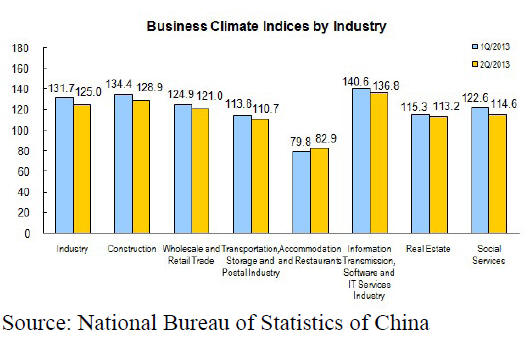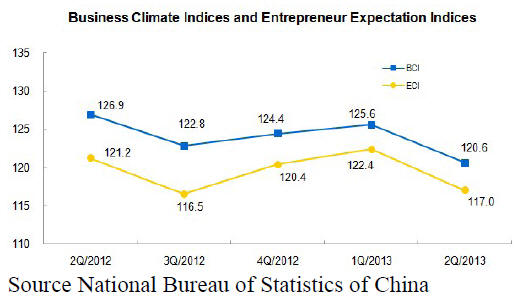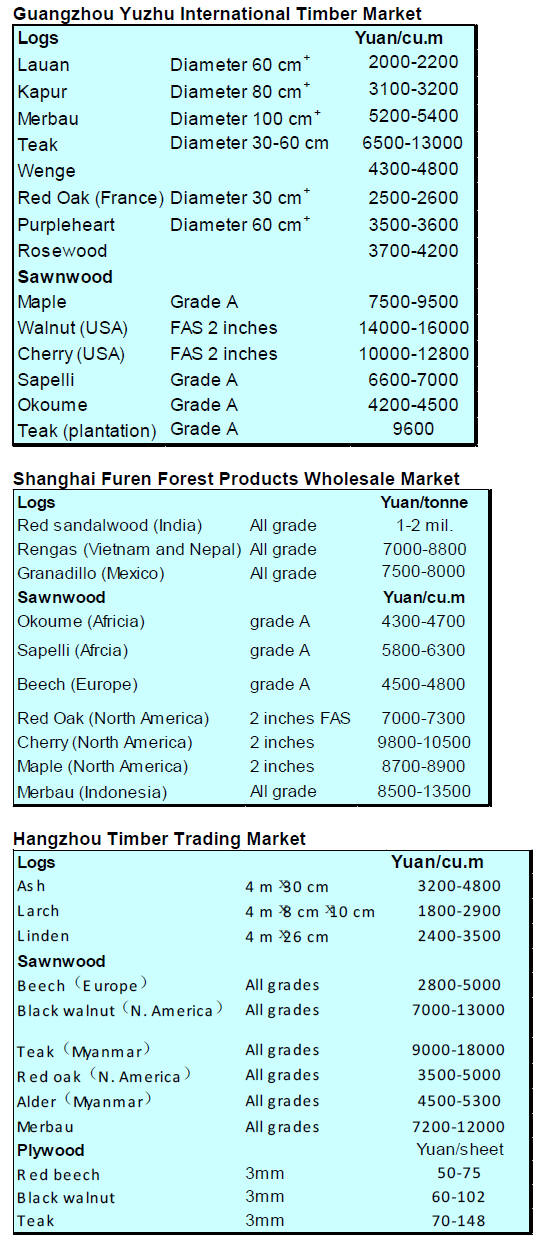US Dollar Exchange Rates of 24th
July 2013
China Yuan 6.1357
Report from China
Prices for newly constructed homes continue to rise
The National Bureau of Statistics of China in a press release has
updated the trends in house prices, see
http://www.stats.gov.cn/english/pressrelease/t20130718_402912311.htm
The report says compared to the previous month prices for newly
constructed residential buildings in the cities surveyed fell in 5
locations, remained at the same in 2 but increased in 63. The highest
month-on-month increase was 2.4 percent.
Compared to levels in May, prices of second-hand residential buildings
fell in 8 cities, remained at the same in 7 and increased in 55 where
the highest month on month increase was 1.3 percent.
Business climate index drops in second quarter
The recent National Business Climate Survey shows that the business
climate index (BCI) was 120.6 in the second quarter, down 5.0 points
quarter-on-quarter, but still significantly higher than the critical
value 100. See:
www.stats.gov.cn/english/pressrelease/t20130716_402911467.htm
In the second quarter, the entrepreneur expectation index (ECI) also
fell to 117.0, or 5.4 points down on the previous quarter.
However, the Bureau reports that, in terms of enterprises profit level,
74% of enterprises indicated that their second quarter í«profit statusí»
was "normal" or "better than normal" slightly better than in the first
quarter.


Income growth spurs domestic consumption
The average disposable income of urban Chinese residents was yuan 13,650
(approx. US$2,200) in the first half of the year, up 9 percent from a
year earlier. The disposable income of rural residents rose to yuan
4,170, up 13 percent year-on-year, according to the National Bureau of
Statistics.
Retail sales of consumer goods rose by 12.7 percent in the first six
months to yuan 11.08 trillion compared to the 12.4 percent growth in the
first quarter. Beijing, Shanghai and Guangzhou, with around 10 percent
of China's population, account for almost a quarter of all consumer
spending.
Eight years on from currency reforms
Currency traders in China recently celebrated the eigth anniversary of
the China exchange rate reform. In the period after the exchange rate
regime was loosened the Chinese currency has strengthened about 35
percent against the US dollar and some 20 percent against the euro.
The People's Bank of China (Central Bank) has said that the current
exchange rate is close to what it terms í░the equilibrium levelí» or the
level where currency demand and supply are balanced.
China loosened the peg of the yuan to the US dollar in mid 2005
allowing a managed floating exchange rate mechanism within prescribed
limits with reference to a basket of currencies.
This change from a fixed exchange rate is helping the yuan become an
international currency.
Changes to transport license regulations to eliminate miss-use
On June 18, the State Forestry Administration (SFA) issued
regulations for supervision and management of timber transport which
goes further in standardising the management of timber transportation.
In the new regulations the transport of plywood, fibreboard, particle
and flake boards, furniture and bamboo furniture as well as wooden
handcrafts should not be included in certificated transport regulations.
Further, imported wood products transported to the final destination
needs no timber transport certificate but if it is to be off-loaded and
re-loaded a transport certificate is required and this will be issued on
presentation of the import permit.
The purpose of the change in regulation is to stop the uncontrolled
expansion in the scope of timber transport certificate issuance as well
as to eliminate unauthorized collection of fees for transportation.
Kunshan wood product exports recover in first half 2013
Statistics from the Inspection and Quarantine Bureau of Kunshan City
indicate that value of first half year wood product and furniture
exports from manufacturers was US$330 million increased.
In the first quarter exports expanded by 15% and by 22% in the second
quarter compared with the same quarters last year, a performance, much
better than in most other parts of China.
Analysts say this accomplishment is impressive given the tough foreign
trade environment in the first half of 2013. In March this year the EU,
the second largest market for wood products from Kunshan, introduced the
EUTR and issued new environmental design requirements for timber and
wood products.
All companies exporting to the EU must now submit evidence of the
legality of the timber used in manufacturing.
The new EU regulation has increased the cost of exporting wood products
and has reduced the competitive price advantage previously enjoyed by
Chinese manufacturers.
Despite the improvement in exports there are risks for the Kunshan
manufacturers as they have been relying on the business of producing
products to importers designs. Such a business model places these
manufacturers at the low end of the production chain and delivers very
slim profit margins.
As global demand for furniture remains stagnant and production costs
rise companies are realising they are at risk.
The authorities in Kunshan have recommended that manufacturers should
make more efforts to diversify their international markets by developing
a trade with African and South American countries.
In addition the Chinese manufacturers are being encouraged to make good
use of local policies to increase competitiveness and reduce reliance on
American and European markets.
Companies are being encouraged to establish their own brands and improve
their quality, develop higher added value products and increase the core
competitiveness of wood product and abandon reliance on low prices.
Imports through Zhangjiagang Port fall in first half 2013
From January to June 2013 timber imports through Zhangjiagang Port
totaled 1,471,200 cubic metres (logs and sawnwood) with a value of
US$346 million. This represents a decline of 9% in volumes handled and a
drop of 12% in the value of imports compared to the same period in 2012.
Log imports were 1,441,200 cubic metres or 98% of the total but down 9%.
Sawnwood imports were 288,000 cubic metres import of which fell 24% from
the same period in 2012. Of the imported timber, 98% was by bulk
carriers and only 2% containerised.
In the first half the number of supply countries was 27, down by 11. In
terms of volumes import volumes fell for all suppliers except for
Equatorial Guinea and Malaysia.
Imports from Oceania amounted to 952,600 cubic meters, from Southeast
Asia 111,000 cubic metres and from Africa 401,300 cubic metres.
Zhangjiagang Port is currently the largest port for imported timber but
it is loosing competitiveness while other ports such as Taizhou, Taicang
and Changshu business are developing rapidly.
Linden market is weak while Korean pine is in short supply
Analysts report that demand for linden or basswood is weak saying
that demand in the home decoration market and by shoe manufacturers has
fallen . Traders are reporting that monthly sales have fallen sharply
and prices have eased considerably.
On the other hand the news in the market is that red pine is in short
supply where in Guangdong prices for 2-4m length, 2.5-5cm thickness red
pine are at yuan 2800-3200 per cubic metre.
Timber markets in NE China face a further tough six months
The timber markets in northeast China have reported very slow
business over past months and sales of most products were much lower
than last year. Traders are saying that even when they lowered prices
there no interest from manufacturers, particularly those supplying
export markets.
It is generally agreed that timber demand in Northeast China will not
recover in the second half of the year.


|